|
Thread Number: 4372
New GE Front Loader! |
[Down to Last] |
Post# 99948 12/26/2005 at 15:32 (6,689 days old) by peteski50  (New York) (New York) |
||

I finally got to see the new GE FL at Sears today in New Jersey. I have to say I am not that impressed. First the positives. Nice design and easy to use controls with simple type operation and selection options. Well built unit compared to some others. And sturdy door opening. Unit does not have tilted drum as some others. In my openion that is neither a positive or negative. Baffels have holes to shower load is a positive compaired to Duet and Hetie. Price at 900 not to bad as compaired to the other monsters. On the Negative side - door is tinted which makes it hard to see progression but not as bad as Hetie. (can probably be resolved by having outer plastic removed from door!) Getting to BIG Negative unit was powered on and I was able to select cycles and see time displays. And cycles are extremly long. For example colors/normal cycle is 113 minutes and that is without a extra rinse. Stain cycle is about 244 minutes. I forget what the others were but all were long. I put the unit on drain/spin which is 13 minutes. I watched the progression and it is almost exactly like my LG combo with the pulse spins and slow Rev Up only this seems worse. I timed it and it took 4 1/2 minutes to go into a full spin. (without laundry in drum). In my opinion extremly ridiculous amout of time to go into a spin. And without laundry in drum. They has a Maysumg 8700 in store - that also had longer than normal cycles but were still shorter than the GE or even my LG. I feel that is probably a better choice. But still debate. My overall opinion I still vote for the Frigmore over all of them even though it doesn't have a heater. To top things off a woman came in and wanted to purchace a large capacity FL washer and dryer. Of cource the sales people didnt know squat. I showed her the Frigmore but she still wanted something bigger. The sales lady pushed the Hetie. I showed her the GE and explained the sequence of cycle progress and she agreed she wouldn't want to wait that long to do laundry. I also pointed out the difference in the Hetie with lack of baffle and spray holes. I feel that showering the clothes makes a difference in performance especially with very little water in the drum. So we went to the Maysumg 8700 she selected that one being we displayed the cycles and they were shorted than the GE. She explained that she used to have the old Frigmore from another house she lived in and liked it but wanted something bigger. She bought the matching maysung washer / gas dryer pair with drawers under. I hope this will work for her. I encourage further comments. Peter | ||

|
Post# 99952 , Reply# 1 12/26/2005 at 16:59 (6,689 days old) by frigilux  (The Minnesota Prairie) (The Minnesota Prairie) |
||
 | ||
Post# 99978 , Reply# 3 12/26/2005 at 20:17 (6,689 days old) by appnut  (TX) (TX) |
||
|
Peter, I will nicely have to say this. NOT EVERYONE is put off by the long cycle times. And some are. Cycle time lengths come with the territory of front loaders with supplementary hearters in North America. I know for you personally it is a negative, but please quit harping on this so darn much. I can tell you, I wou,ld much rather have clean clothes without being shredded and a larger capacity and better treatment of stains than what I have right now as a Shredmore. Sure, I know I will have to adjust laundry habits some, but if I had a choice, a Fridgemore would NOT be my choice because it DOESN'T have a heater and I need one because I have to keep my water heater at 120, electtricty has goten expensive for me. I"m sorry if this ruffled your feathers, but I finally had to get this off my chest and vent. And by the way, when I wawsh whites, I have to presoak for 1/2 hour in cool water and wash in hot with a 2 hour soak with oxiclean. I think I would save some time with a front loader. ONe of the things I did love about Glenn's F&P is that it held more than my 3.0+ cu. ft. Shredmore and because of that, I eneded up using less water per 1.5 loads I have to cmoparably do in my Shredmore.
| ||
Post# 100003 , Reply# 4 12/26/2005 at 22:48 (6,689 days old) by launderess  (Quiet Please, There´s a Lady on Stage) (Quiet Please, There´s a Lady on Stage) |
||
 | ||
| Post# 100009 , Reply# 5 12/26/2005 at 23:29 (6,689 days old) by golittlesport (California) | ||

I can't believe those cycle times! Something must be wrong, even if it was calculating heating the water. One could heat the water holding a match faster than 4 hours! I don't mind some extended cycles for special circumstances (i.e. the "profile" wash or soak cycle) but I would like a normal/colors cycle within an hour. I wonder if they really run that long.
| ||
Post# 100015 , Reply# 6 12/27/2005 at 00:41 (6,689 days old) by appnut  (TX) (TX) |
||
|
Rich, I played with the interactive control panel on the GE Website. It may not be accurate tho, the longest for the normal colors with heavy soil was 1:12. My best suggestion to you is if you're really interested in this machine, find a live one at a store near you and play with the control panel to see what different soil levels are and what the times are for each of those levels per cycle. I have a sneaky suspicion the time way whittle down faster once temp is reached. I know this happens on the Hetties. I'm not willing to throw the towel in on these new fangled ones yet.
| ||
Post# 100016 , Reply# 7 12/27/2005 at 00:42 (6,689 days old) by sudsmaster  (SF Bay Area, California) (SF Bay Area, California) |
||

I think one must adjust the Soil Level to change the wash times. I suspect Pete selected (or didn't change a default) of the heaviest soil level, which could account for the long cycle times. FWIW, for the cleanest results, long wash times in front loader are preferable. However, 2 hours is a bit much for a load of lightly soiled perm press. | ||
Post# 100022 , Reply# 8 12/27/2005 at 01:15 (6,689 days old) by launderess  (Quiet Please, There´s a Lady on Stage) (Quiet Please, There´s a Lady on Stage) |
||

Actually long cycle times can lead to soils redeposting on laundry causing "tattle-tale" grey results. Detergents/soaps used for laundry have a finite time their chemicals can keep soils in suspension, thus away from fibers. Once this time is reached the product begins to loose effectivness and the ability to keep the removed dirt away, thus the dirt finds it's way back onto laundry. Look up the causes of grey laundry and you will see "long cycle times". One of course can counter this by adding lots of detergent or more as the cycle progresses. IIRC some European laundry detergents were/are desinged for long cycles but as washing washers have gotten better and to meet the demands of many consumers who do not have time/wish to wait for long cycle times, Persil amoung many European laundry detergents has formulas designed for short wash cycles. Speed Queen's home line takes a cue from commercial washers and has sort cycles. Which is kind of good for machines without internal heaters because hot and warm water will not cool down as much as they do during long cycles. The only laundry process which benefits from long contact times would be oxygen bleaching which requires long contact time, especially with warm and cool water. Schutless (sp?) the European washer maker explains on their website that other front loaders need long wash times because of their poor design. And remember long wash/cycle times can mean increased risk for laundry becoming damaged from all that tumbling around. Front loaders are more gentle than top loading washers, but one is still subjecting textiles to rubbing/scrubing and slight abrasion as laundry hits the sides of the tub/rubs against each other. Launderess | ||
Post# 100040 , Reply# 9 12/27/2005 at 07:31 (6,688 days old) by peteski50  (New York) (New York) |
||
Long Cycle Times!
When I tested the cycle times I tried it on a spin drain cycle. Without laundry in the machine it took 4 1/2 minutes to ramp up to a full spin. This is where all the extra time is consumed from (the balancing) just like my LG. I did make adhustments to the soil level options and cycles were still rather long! All the extra time comes from balancing before the spinning takes place. Peter | ||
| Post# 100053 , Reply# 10 12/27/2005 at 09:29 (6,688 days old) by jasonl (Cookeville, TN) | ||
|
Ironic It's ironic how in the beginning of automatic washers, the 'matics were advertised having short cycle times to speed up washday so the modern housewife could do other things besides. Now in the age of liberated 2 job/single/kids/in a rush/independant women, we're seeing washers that take forever to wash clothes. | ||
Post# 100084 , Reply# 12 12/27/2005 at 12:39 (6,688 days old) by launderess  (Quiet Please, There´s a Lady on Stage) (Quiet Please, There´s a Lady on Stage) |
||

Wash times for whites at 140 is about one hour and a half. Don't really "watch" the clock anymore as the novelty of laundry sometimes wears off when one has so many other things to do! *LOL* Detergent wise have several but mainly use Cheer Free and Gentle power. Additives: oxygen bleach (Ecover or Spray and Wash "pink". That is pretty much it, oh yes, now and then some STPP, but that depends on soil level and what detergent is being used. When using Tide Coldwater for instance no STPP is required and everything comes out quite clean. Long Cycle Times On Modern Front Loaders: Am convinced these long cycle times for American front loaders are the result of several design "flaws" (if one could call them that): 120v power used for water heating is going to take awhile with a 5 or 6 kilo washer, so imagine how long it takes with larger units. Poor inner and outer tub size in relation to each other. Many of these units simply do not hold enough water to do the job well, and rely on all sorts of gimmicks to get water into the laundry. Bendix in the past and many commercial front loaders like "Schultess" (sp?) get the job done by making sure the units hold enough water. Also have a theory that the larger units suffer again from running on 120v power in that their motors are not the robust non-stalling single or double phase 220v motors used in commercial units. For that matter they are probably not as robust as commercial 120v motors either. Hence everything must be with kid gloves. Rather than just getting on with spins, these units seem to take forever to reach some sweet spot of perfect balance. Again using commercial units as an example, they usually do not bother with all that palaver of balancing for ages, they just rev up and away they go. Of course one can only do so much with units that contain so much plastic like the new uber home units. Personally I'd rather have a large unit like the ADC "Solaris" or even the Miele soft mount than bother with these uber home units. Just have a feeling these units are not built to handle large loads of laundry day in and day out. Sure one can wash a king sized down comforter, but would'nt try doing them once a week for the lifetime of the unit. Launderess | ||
Post# 100219 , Reply# 14 12/27/2005 at 21:43 (6,688 days old) by sudsmaster  (SF Bay Area, California) (SF Bay Area, California) |
||

Pete, It also looks like you are mis-reading the timer on the GE FL. Where you see 113 minutes, the washer is really telling you 1 hr 13 minutes, or a total of 73 minutes. Where you see 244 minutes, the washer is really telling you 2 hours 44 minutes (admittedly a long time, but a lot less than the four+ hours you were fearing). As for the dumping on modern washer cycle times, the longest cycle I can wring out of my Neptune 7500 is 109 minutes. I'd even go for longer if it would do it. Graying is not an issue because I use STPP, which doesn't allow much if any dirt to redeposit on laundry - unlike modern powders that rely on sodium carbonate and soluble lint (carboxymethylcellulose) to keep soil suspended. I think we should probably wait for some real world user reports before we start to dismiss the GE FL. | ||
Post# 100383 , Reply# 16 12/28/2005 at 19:56 (6,687 days old) by sudsmaster  (SF Bay Area, California) (SF Bay Area, California) |
||

Nathan, I'll leave the stereotyping-based-on-electrical-standards out of my reply ;-) However, American 220 voltage, energy-wise, is just as efficient as European 220 voltage. The main difference is that the American 220 has two hot legs, whereas the Euro version has only one hot leg. The same amount of current will flow through either circuit for the same wattage or HP. I don't know the technical reason why North America settled on 110 volts as its single hot line standard. In truth, 110 volt single hot, 220 volt single hot, and 220 volt dual hot are all single phase, and are all equally inefficient when it comes to powering AC motors. The most efficient way to power an AC motor is to use 3 phase circuitry. In the USA, this type of line power exists, but is primarily restricted to industrial and commercial buildings. It could be argued that 220 volt single hot single phase is more efficient than 110 volt single hot single phase, since a smaller conductor (1/2 the cross sectional area) is needed with 220 single hot to provide the same amount of power as 110 single hot. On the other hand, the lower voltage of a 110 circuit might be considered somewhat safer than the higher 220 voltage. Lower voltage means less tendency to arc across insufficient insulation. But either one could injure or even kill a person. Anyway, it's a problem for washers here, since a 220 volt front loader could use a heating element with twice the wattage of one installed in a 110 volt machine. That's why virtually all electric dryers and electric ranges in the USA run on dual-hot single phase 220. On the other hand, I believe one of our Euro friends has mentioned that in the case of one Miele model, the heating element was too powerful and had to be downsized (or slowed down) to give a more gentle rise in heat for bio type wash cycles. There is probably a good niche for a GE FL size washer that runs on dual hot 220 voltage. Many homes and laundry rooms already have 220 outlets for electric dryers. The 220 washer could plug into the dryer outlet, and then a gas dryer could be used instead of an electric one. Certainly this market would be smaller than that for a 110 volt washer, but I believe there would still be a demand once consumers with the appropriate hookups get the full picture. And even those with no gas service could always get a second 220 volt ciruits run to the laundry room. | ||
Post# 100430 , Reply# 17 12/29/2005 at 05:23 (6,686 days old) by launderess  (Quiet Please, There´s a Lady on Stage) (Quiet Please, There´s a Lady on Stage) |
||

Forget "niche" appliances from today's US washer and dryer manufacturers. It is all about efficent production, which means one or maybe two models in the BOL,MOL and TOL sections that will work everywhere from Canada to Mexico. As for 220v power, even Bosch succumbed and built a plant in the United States to churn out 110v washers and dryers for the US market, leaving Miele the remaining hold out. Yes, many US homes are wired for 220v in the laundry area for dryers,but obviously those doing marketing/demographics do not think the market is sufficently large enough to produce a domestic 220v washing machine. Methinks the rationale behind this train of thought is that American homes have large hot water heating capacity,thus these uber front loaders really only need to "boost" and or maintain warm and hot water temps. There are however a few large washers, like the Nexxt which will take in cold and heat to hot, but it does take awhile owing to 110v power. What is interesting is that the little Danby washer, with it's 110v heater has cycle times about equal with Miele even when heating cold to hot water. IMHO all the complaints about pilling and other damaged laundry from these large US front loaders can be partly caused by the long cycle times (especially when heating water) and low water levels. Laundry is literally being "beaten" for an hour or more as the washer goes through it's cycles. L. | ||
Post# 100626 , Reply# 19 12/29/2005 at 20:33 (6,686 days old) by sudsmaster  (SF Bay Area, California) (SF Bay Area, California) |
||

"As for 220v power, even Bosch succumbed and built a plant in the United States to churn out 110v washers and dryers for the US market, leaving Miele the remaining hold out. " Did Asko go out of business, or pull out of the US market? "Forget "niche" appliances from today's US washer and dryer manufacturers. It is all about efficent production, which means one or maybe two models in the BOL,MOL and TOL sections that will work everywhere from Canada to Mexico. " Sorry, but front loaders ARE a niche appliance, still, to begin with. They are getting more popular, that's true, but the vast majority of washers sold in the USA are still traditional agitator designs. It would not take a major redesign to provide a current American style large front loader with a 220 volt option. All it would be needed for, really, is for the water heater. That is a relatively minor change. I know I'd be willing to pay an extra $100 or so for that option, and I'm pretty sure others here would be so willing also. It's more a matter of myopic appliance marketing than the lack of a market. "Given the longer drying times of 110 volt dryers, I'd like to see one built with a slower rotation speed to reduce the rubbing/wear on fabrics. I don't even think this would lengthen the cycle, since the tumbling is primarily for the purpose of letting the air flow through every article in the load. " Miele's literature stresses that the rotation speed must be just so for the laundry to drop from the top of the drum to the bottom and splash into the pool of water at the bottom. Too slow a rotation speed, and the load will just roll in the drum. Too fast, and the laundry won't fall at all, but will stick to the top of the drum all the way through. I'm not convinced that low water levels and long cycle times are responsible for pilling, anyway. In my experience it has more to do with mixing pill-prone fabrics with lint-prone fabrics. It can also result from mixing heavy fabrics (like cotton towels) with lightweight fabrics (like cotton/poly blend dress shirts). The heavy cotton tends to beat up the light fabrics, as well. Additionally, in machines such as the Maytag Neptune, the longer cycles can be accomplished by simply inserting longer pauses between tumbles. This means that there is virtually no more wear on the fabrics than would be experienced with the same cycle without the stain cycle option. | ||
Post# 100627 , Reply# 20 12/29/2005 at 20:34 (6,686 days old) by sudsmaster  (SF Bay Area, California) (SF Bay Area, California) |
||
 | ||
Post# 100643 , Reply# 21 12/29/2005 at 21:12 (6,686 days old) by frigilux  (The Minnesota Prairie) (The Minnesota Prairie) |
||
 | ||
Post# 100680 , Reply# 23 12/30/2005 at 00:03 (6,686 days old) by sudsmaster  (SF Bay Area, California) (SF Bay Area, California) |
||

Tracee... Sounds like something is wrong. There is no way with a modern front loader with a 1,000 rpm spin that you should be able to wring any water from towels after a fast spin. I am wondering if the transit bolts were not removed, so the washer never gets up to full speed. Of course, it's also possible that this new model is having the usual teething problems that we've seen with other brands, such as Neptune, HE3T, LG, etc. Before you give up on the GEFL perhaps you should ask for a replacement. | ||
Post# 100690 , Reply# 24 12/30/2005 at 01:01 (6,686 days old) by sudsmaster  (SF Bay Area, California) (SF Bay Area, California) |
||

Here's a link to an article by a GE FL owner... she seems quite happy with her washer/dryer set... She says that the cycle she uses the most takes over an hour... that must be the one the machine intially estimates at 1 hour 14 minutes. For comparison, the cycle I use the most in my Neptune takes about 1 hour (Normal wash, extra rinse). So the GE FL times are not too far off base. | ||
Post# 101092 , Reply# 27 1/1/2006 at 17:00 (6,683 days old) by sudsmaster  (SF Bay Area, California) (SF Bay Area, California) |
||

" I did note, however, that the GE front loader is missing the following: sanitary cycle and auto soak (or bulky wash) cycle. " It may be a semantic difference. All three models' control panels pictured in the owner's manual (downloadable from the GE website) indicate that they all have the Sanitize wash temp setting, as well as the "Prewash" option (which is really a presoak, suitable for bulky item handling). I really do think GE has a winner on their hands with this model. Especially since some customers have been able to order it on-line for under $650. | ||
Post# 101109 , Reply# 29 1/1/2006 at 18:29 (6,683 days old) by sudsmaster  (SF Bay Area, California) (SF Bay Area, California) |
||

Hm... Well, yes, but since these machines have automatic water level control, the pre-wash should be able to thoroughly saturate a bulky item, by adding more water as the item soaks it up. To my thinking, the big problem with bulky items such as poly-filled comforters, is that they can tend to shed water, and take longer to get thoroughly wetted than smaller, less bulky items. A prewash (which also has occasional tumbles) will avoid this issue. I'm not sure that a bulky/autosoak setting would do much better. My Neptune has a presoak option, which works well on bulky items. | ||
Post# 101202 , Reply# 31 1/2/2006 at 02:56 (6,682 days old) by sudsmaster  (SF Bay Area, California) (SF Bay Area, California) |
||
 | ||
| Post# 102280 , Reply# 33 1/7/2006 at 13:13 (6,677 days old) by whirlcool (Just North Of Houston, Texas) | ||
|
Here are a few pages of the GE brochure for their new frontloaders. I hope you enjoy! 
| ||
| Post# 102281 , Reply# 34 1/7/2006 at 13:17 (6,677 days old) by whirlcool (Just North Of Houston, Texas) | ||
|
And page2... 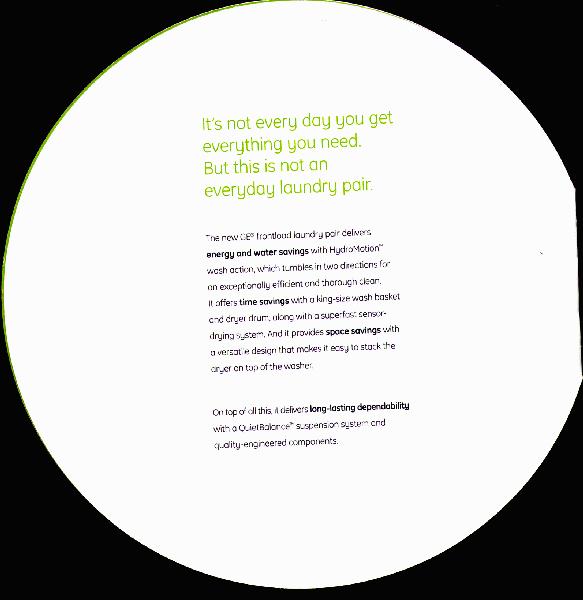
| ||
| Post# 102283 , Reply# 35 1/7/2006 at 13:18 (6,677 days old) by whirlcool (Just North Of Houston, Texas) | ||
|
Page 3.... 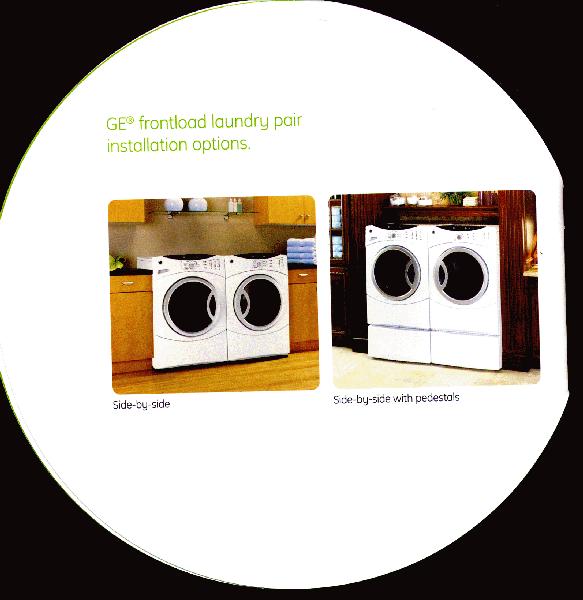
| ||
| Post# 102284 , Reply# 36 1/7/2006 at 13:19 (6,677 days old) by whirlcool (Just North Of Houston, Texas) | ||
|
More installation options.... 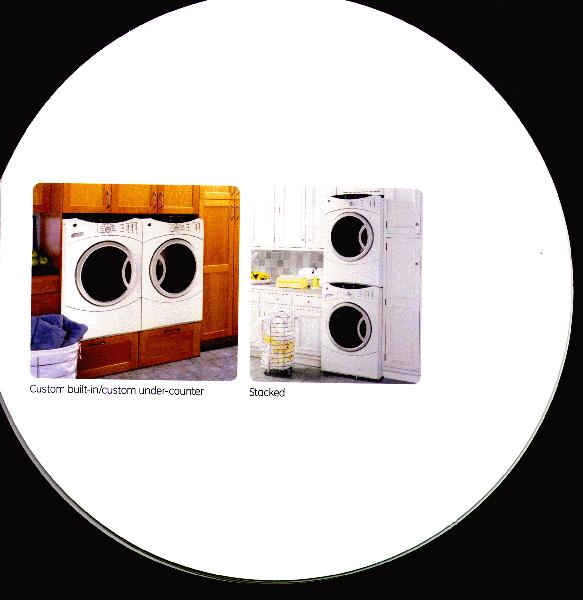
| ||
| Post# 102285 , Reply# 37 1/7/2006 at 13:21 (6,677 days old) by whirlcool (Just North Of Houston, Texas) | ||
|
Ah, the temperature spec! 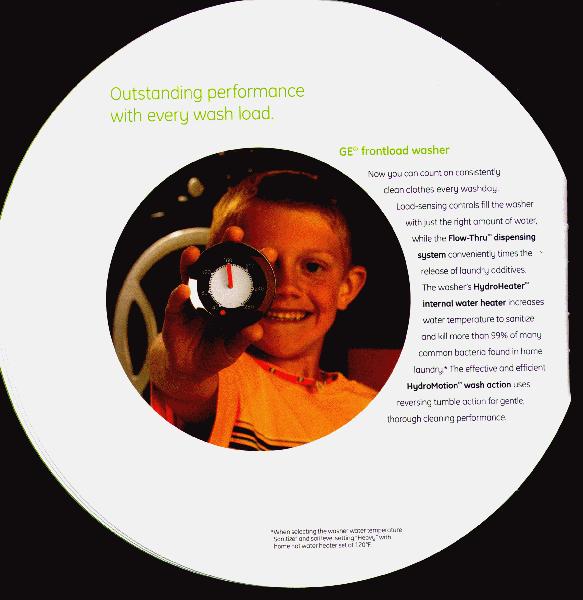
| ||
| Post# 102287 , Reply# 38 1/7/2006 at 13:43 (6,677 days old) by whirlcool (Just North Of Houston, Texas) | ||
|
And now for page 6... 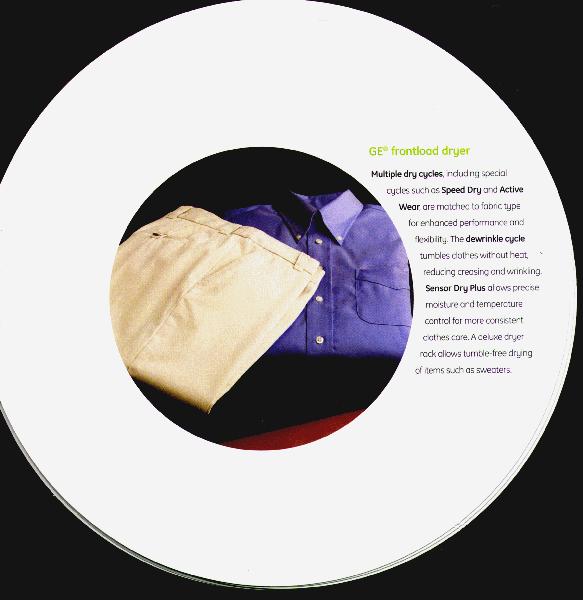
| ||
| Post# 102288 , Reply# 39 1/7/2006 at 13:44 (6,677 days old) by whirlcool (Just North Of Houston, Texas) | ||
|
Next, page 7 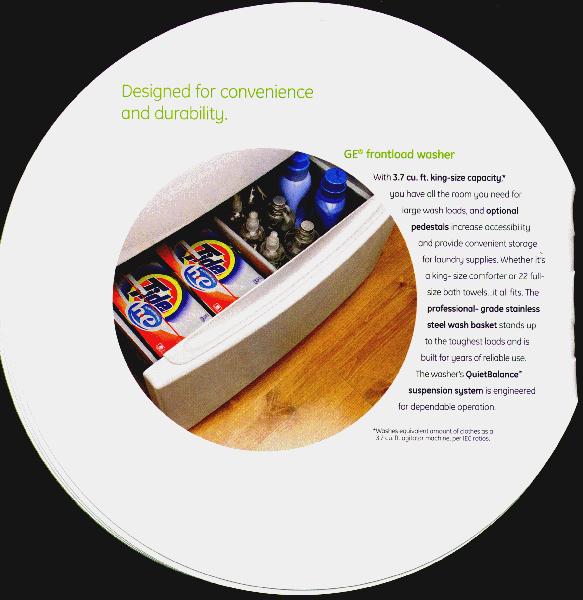
| ||
| Post# 102289 , Reply# 40 1/7/2006 at 13:45 (6,677 days old) by whirlcool (Just North Of Houston, Texas) | ||
|
And finally, page 8 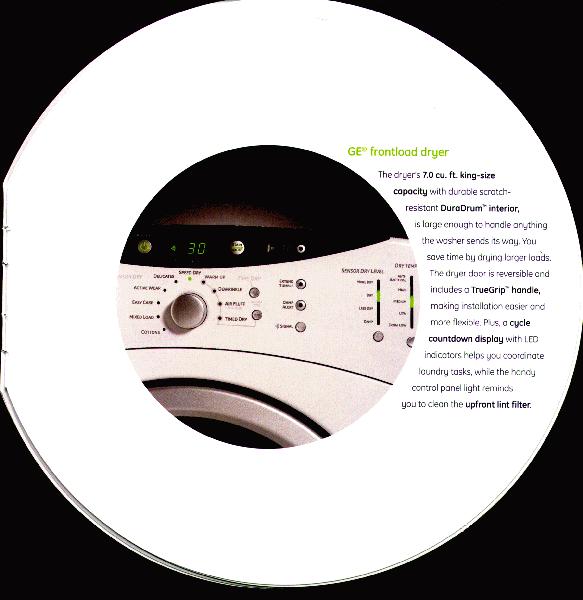
| ||
Post# 102292 , Reply# 41 1/7/2006 at 14:21 (6,677 days old) by appnut  (TX) (TX) |
||
|
| ||
| Post# 102295 , Reply# 42 1/7/2006 at 14:50 (6,677 days old) by whirlcool (Just North Of Houston, Texas) | ||
|
I scanned in all the pages with writing on them, there were a page or two that just had a photo of earth from space with no information on the page, I skipped those pages. 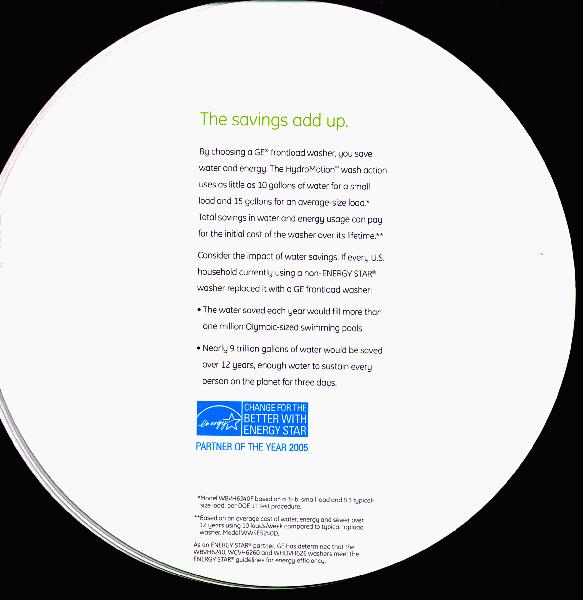
| ||
| Post# 102389 , Reply# 44 1/8/2006 at 00:15 (6,677 days old) by mistervain () | ||
|
How can these new FL's claim to be so energy-friendly when they have to waste tons of electricity in wash times to make up for insufficient water use?? | ||
Post# 102392 , Reply# 45 1/8/2006 at 00:59 (6,677 days old) by dadoes  (TX, U.S. of A.) (TX, U.S. of A.) |
||
|
| ||
Post# 102484 , Reply# 47 1/8/2006 at 13:23 (6,676 days old) by sudsmaster  (SF Bay Area, California) (SF Bay Area, California) |
||
 | ||

 Comes to the Rescue!
Comes to the Rescue!